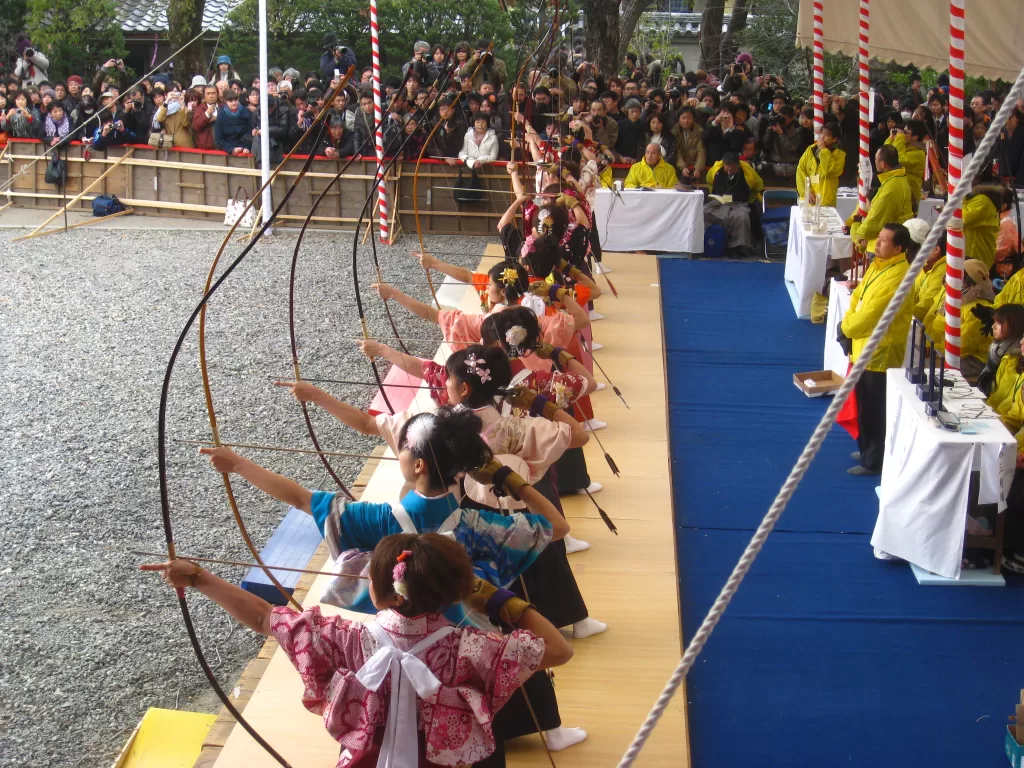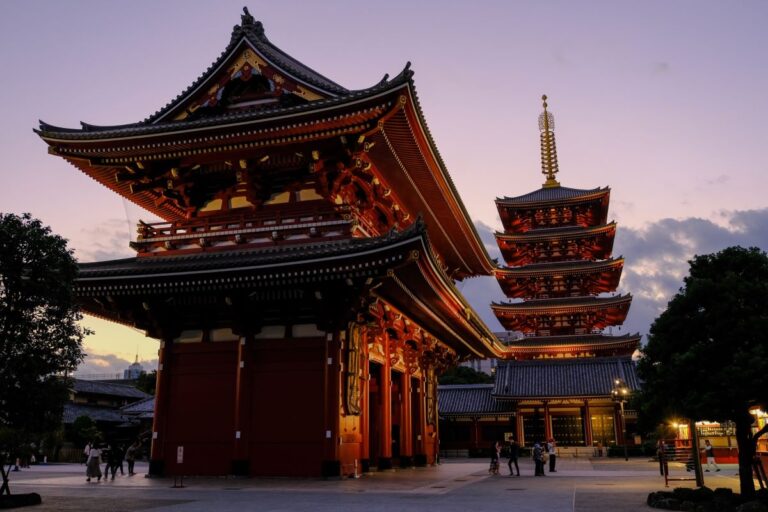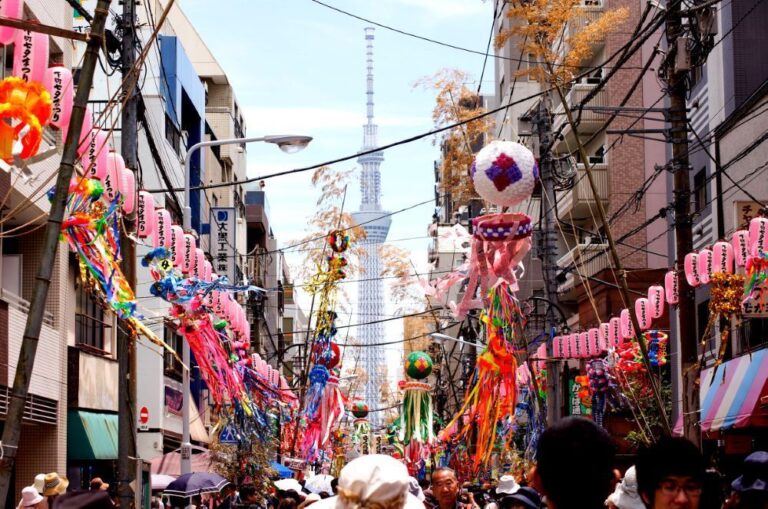The Ōmato National Archery Competition, also known as the Ōmato Taikai ritual, is a mesmerizing event that brings centuries-old traditions to life.
Held at the historic Sanjūsangen-dō Temple in Kyoto, Japan, this coming-of-age ceremony showcases the skill and precision of young archers. From the moment the master archer releases the first arrow, the air is filled with anticipation.

Participants, clad in the elegant hare-gi ensemble, take their turns hitting the distant target.
With its rich heritage, captivating rituals, and vibrant atmosphere, the Ōmato Taikai is an immersive cultural experience that transports spectators to the heart of Japan’s traditions.
Key Takeaways
- The Ōmato Archery Ritual, also known as the Ōmato Taikai, is a traditional coming-of-age ceremony held at Sanjūsangen-dō Temple in Kyoto, Japan.
- The ritual has historical roots in the Tōshiya competition, which was initiated in 1606 by a Samurai who demonstrated Kyudo expertise by shooting 100 arrows down the temple.
- The Ōmato Taikai involves young adults taking turns shooting two arrows at a target 60 meters away within a two-minute time limit.
- The event showcases Japan’s traditions and festivity, with participants and spectators immersing themselves in vibrant cultural experiences such as the Rite of Willow and the Hadaka Odori traditional dance.
What is it?
The Ōmato Taikai ritual, rooted in the historical Tōshiya competition, is a coming-of-age ceremony held annually at Sanjūsangen-dō Temple. Young adults take turns shooting two arrows at a target 60 meters away within a two-minute time limit.
This ritual holds great significance and symbolism in Japanese culture, representing the transition from adolescence to adulthood. It is a test of skill, focus, and discipline, as participants must hit the target with both arrows.
The evolution and modernization of this ritual can be seen in the incorporation of new techniques and equipment, such as the use of modern bows and arrows. Despite these changes, the core values of the ceremony, such as respect for tradition and the pursuit of personal growth, remain intact.
The Ōmato Taikai ritual continues to be a cherished tradition, showcasing Japan’s rich cultural heritage and providing a platform for young adults to prove their worth and mark their entry into adulthood.
History and Significance
Visitors can participate in the special purification rite conducted by priests during the Ōmato Taikai competition. This ritual holds deep historical roots and is a testament to the origins of the event.
To better understand its significance, let’s delve into the past. The Ōmato Taikai ritual finds its origins in the traditional Tōshiya competition that dates back to the 17th century. This archery marathon event lasted for several days, with participants firing thousands of arrows, some of which became embedded in the temple beams.
It was in 1606 when a Samurai initiated Tōshiya by showcasing his Kyudo expertise, shooting 100 arrows down the temple. This annual Kyudo contest eventually turned into the Ōmato Taikai we know today.
Ritual Details and Rules
Participants in the Ōmato Taikai competition must adhere to the strict rules and regulations set forth by the organizers. Ritual etiquette and archery techniques play a crucial role in this ancient event.
As the participants step onto the shooting line, they must demonstrate the utmost respect for the ritual’s traditions. Bowing to the target, they draw their arrows with precision and focus. The archers take their stance, their bodies aligned with the target, and their minds calm and centered.
With a deep breath, they release their arrows, the sound of the bowstring cutting through the air. The archers must maintain their composure and control, even amidst the pressure of the competition. Their aim is not only to hit the target but also to honor the spirit of the Ōmato Taikai ritual.
Through their disciplined practice and mastery of archery techniques, they embody the grace and elegance of this historic event.
Cultural Experiences and Attractions
Immersing themselves in the vibrant traditions of the Ōmato Taikai competition, spectators are treated to a rich cultural experience that reflects Japan’s heritage.
As they gather at the Sanjūsangen-dō Temple, visitors are captivated by the sight of participants dressed in traditional attire. Women don the elegant hare-gi, a special ensemble consisting of a furisode kimono, obi, and hakama pants, adorned with hair ornaments and accessories that add color and charm to the event.
But it’s not just the traditional attire that enthralls the onlookers; it’s also the archery techniques on display. As the archers take their positions, they showcase their skill and precision, shooting arrows with grace and accuracy.
Spectators can’t help but be amazed by the mastery of the participants, as they hit the target 60 meters away, not once, but twice. The Ōmato Taikai competition truly offers a cultural experience like no other, where tradition and archery techniques come together in a mesmerizing display of Japan’s rich heritage.
Immersive Traditions and Dance
As the rhythmic beats of traditional drums fill the air, spectators at the Ōmato Taikai competition are drawn into the captivating Hadaka Odori dance, a vibrant display deeply rooted in history and faith. This immersive experience transports visitors to ancient Japan, allowing them to witness a beautiful tradition that has been passed down through generations. The Hadaka Odori dance is a mesmerizing spectacle, with performers clad in colorful costumes and gracefully moving to the rhythm. The dance tells a story of celebration and reverence, connecting the present with the past. Its historical roots can be traced back to ancient religious rituals and festivals, making it a significant part of Japan’s cultural heritage. The Ōmato Taikai competition not only showcases the skill and precision of archers but also immerses spectators in the rich traditions that have shaped Japan’s history.
| Emotion | Description | Example |
|---|---|---|
| Awe | The audience is in awe of the dancers’ grace and beauty. | The dancers move with such elegance and precision, leaving the audience in awe of their talent. |
| Excitement | The audience is filled with excitement as they watch the vibrant dance. | The lively music and colorful costumes create an atmosphere of excitement, making it hard for the audience to resist tapping their feet. |
| Wonder | The audience is filled with wonder at the historical significance of the dance. | As the dancers perform, the audience can’t help but wonder about the stories and traditions behind the dance, adding to the sense of mystery and allure. |
| Joy | The audience experiences a sense of joy and happiness while watching the dance. | The infectious energy of the dance and the smiles on the dancers’ faces spread joy throughout the audience, creating a festive atmosphere. |
| Reverence | The audience feels a deep sense of respect and reverence for the tradition. | The dancers’ movements are imbued with a sense of grace and spirituality, evoking a feeling of reverence in the audience. |
Frequently Asked Questions
How long has the Ōmato Taikai ritual been celebrated at Sanjūsangen-dō Temple?
The Ōmato Taikai ritual has been celebrated at Sanjūsangen-dō Temple for many years, showcasing Japan’s rich history and cultural traditions. This historical event, steeped in tradition and evolution, has become a significant part of the temple’s annual festivities.
What is the significance of the Master archer firing the first shot in the Ōmato Taikai ritual?
The significance of the master archer firing the first shot in the Ōmato Taikai ritual lies in the importance of setting the tone and showcasing skill. It symbolizes leadership, expertise, and sets the standard for the young adults participating.
How many arrows did participants shoot during the traditional Tōshiya competition?
Participants in the traditional Tōshiya competition showcased their archery skills by shooting hundreds of arrows. This ancient event, initiated by a Samurai in 1606, involved firing thousands of arrows and embedding them in temple beams.
What is the purpose of the special purification rite (Rite of Willow) conducted by priests during the Ōmato Taikai competition?
The special purification rite, known as the Rite of Willow, conducted by priests during the Ōmato Taikai competition holds great significance. It is believed to ward off headaches and allows visitors to participate. Plus, participants can immerse themselves in the vibrant traditions by joining the traditional dance during the ritual.
Can visitors participate in the Hadaka Odori traditional dance during the Ōmato Taikai ritual?
Visitors are welcome to participate in the Hadaka Odori traditional dance during the Ōmato Taikai ritual. There are no participation restrictions, and it offers a cultural significance, immersing visitors in vibrant traditions and reflecting Japan’s rich heritage.
The Sum Up
To sum it up, the Ōmato National Archery Competition, also known as the Ōmato Taikai ritual, is a captivating and culturally rich event that showcases Japan’s traditions in a mesmerizing way.
With its historical roots in the traditional Tōshiya competition, this coming-of-age ceremony brings together master archers and young adults to compete in shooting arrows at a target 60 meters away.
The women’s special ensemble, the hare-gi, adds a touch of elegance and charm to the event. With demonstrations by older archers and a purification rite conducted by priests, the Ōmato Taikai offers a truly immersive experience that captures the essence of Japan’s heritage.
Whether you’re a spectator or a visitor, this event will leave you in awe of the traditions unleashed during this extraordinary archery ritual.




